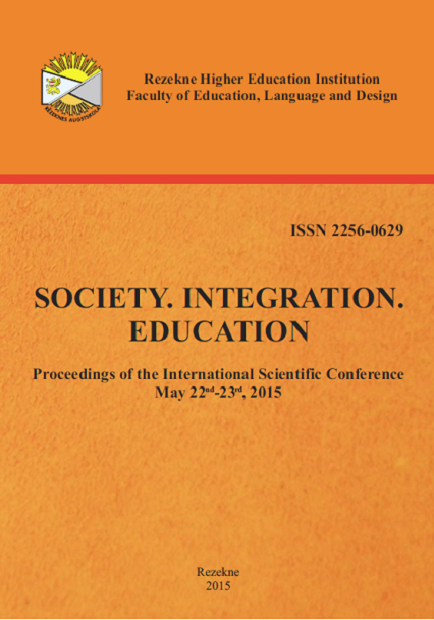Athletic Identity of Students Actively Involved in Sports and Its Relationship with Induced Stress
DOI:
https://doi.org/10.17770/sie2015vol3.474Keywords:
athleticidentity, stress, students, sportAbstract
Theexpression of the athletic identity in academic environments may become a stress-reducing and a stress-enhancing factor depending on the conditions of the environment when expressing one’s athletic identity (Chen et al., 2010).Methods. 214 students (105 females and 109 males) took part in the research. All of them were first year students of the first level of studies (i.e. BA studies) at Lithuanian Sports University. All the students were actively practicing sports. Their age ranged from 18 to 25 with the age average of 19.24 (0.76). Thestudymadeuseofquestionnaires: ReederStressAssessmentScale and Athletic Identity Questionnaire (AIQ).Conclusions. The stress levels experienced by students actively practicing sports and possessing a more prominent athletic identity yet not going for results in sports are lower than those experienced by students with a less prominent athletic identity.
Downloads
References
Anderson C. B. (2004).Athletic identity and its relationto exercise behavior: scale development and validation. Journal of Sport and Exercise Psychology, 26(1), 39-56.
Anderson, C. B., Masse, L. C., Hergenroeder, A. C. (2007). Factorial and Construct Validity of the Athletic Identity Questionnaire for Adolescents. Medicine and Science in Sports and Exercise, 39 (1), 59–69.
Banayi, N., Nikbakhsh, R., & Zargar, T. (2014). The Relationship between Aggressions with Athletic Identity on Shiraz Team Sports. Bulletin of Environment, Pharmacology and Life Sciences, Vol 3 (IV), 57-60.
Brewer, B.W., Van Raalte, J.L., & Linder, D.E. (1993). Athletic Identity: Hercules’ Muscles or Achilles Heel? International Journal of Sport Psychology, 24, 237-254.
Chen, S., Snyder, S., &Magner, M. (2010). The Effects of Sport Participation on Student-Athletes’ and Non-Athlete Students’ Social Life and Identity. Journal of Issues in Intercollegiate Athletics, 3, 176-193.
Esfahani, A. R. N., Khorzoghi, M.B., & Ahmadi, E. (2014). Relationship between Social Intelligence with Athletic Identity among Wushu Athletes. Scholars Journal of Arts, Humanities and Social Sciences, 2(3B), 428-433.
Finch, B. (2009). Investigating College Athletes’ Role Identity and Self-efficacy for Career Decision-making. International Journal of Sport Management, 10, 427-435.
Goštautas, A. (1999). Psichologiniai streso aspektai. Sveikata, 6, 55–58.
Houle, J.L.W., Brewer, B.W. & Kluck, A.S. (2010) Developmental Trends in Athletic Identity: A Two-part Retrospective Study. Journal of Sport Behavior33(2): 146-159.
Lally, P.S., &Kerr, G.A. (2005). The Career Planning, Athletic Identity, and Student Role Identity of Intercollegiate Student Athletes. Research Quarterly for Exercise and Sport, 76, 275-285.
Miller, K. (2009). Sport-related Identities and the “Toxic Jock.” Journal of Sport Behavior, 32(1), 69-91.
Reeder, L.G., Chapman, J.M., &Coulson, A.H. (1968).Socioenvironmental stress, tranquilizers and cardiovascular disease.Proceedings of the Excerpta Medica International Congress Series, 182, 226–238.
Riemel, L. (2009). Sportliche Identität der Studenten im ersten Jahr. Zeitschrift für Soziologie, 4, 45-65.
Shaffer, D.R., &Wittes, E. (2006). Women’s Precollege Sports Participation, Enjoyment of Sports, and Self-esteem. Sex Roles, 55(3/4), 225-232.
Valente, L. (2004). What Can We Learn from the Student-athlete? Phi Kappa Phi Forum, 84(4), 14.
Williams, J. (2008). Mental Health in Young Adults and its Relation with Self-esteem. JournalofSport, 5, 11-19.
Wolniak, G.C., Pierson, C.T., & Pascarella, E.T. (2001). Effects of Intercollegiate Athletics Participation on Male Orientations toward Learning. Journal of Collegiate Student Development, 42(6), 604-624.


